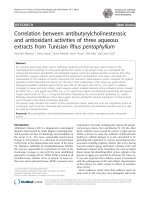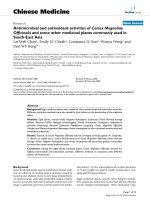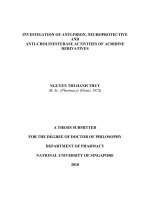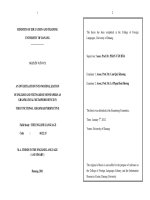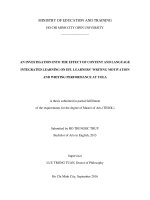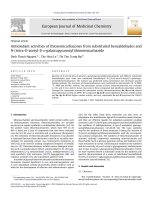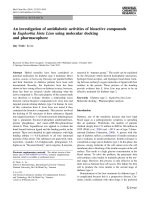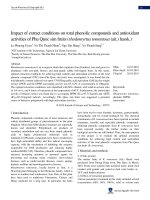Investigation of antibacterial, pholyphenol content and antioxidant activities of chinese wedelia, camphor laurel and vietnamese yellow chrysanthemum
Bạn đang xem bản rút gọn của tài liệu. Xem và tải ngay bản đầy đủ của tài liệu tại đây (2.44 MB, 73 trang )
VIETNAM NATIONAL UNIVERSITY OF AGRICULTURE
FACULTY OF BIOTECHNOLOGY
------- -------
GRADUATION THESIS
INVESTIGATION OF ANTIBACTERIAL,
POLYPHENOL CONTENT AND ANTIOXIDANT
ACTIVITIES OF CHINESE WEDELIA, CAMPHOR
LAUREL AND VIETNAMESE YELLOW
CHRYSANTHEMUM
Hanoi- 2022
VIETNAM NATIONAL UNIVERSITY OF AGRICULTURE
FACULTY OF BIOTECHNOLOGY
------- -------
GRADUATION THESIS
TITLE:
INVESTIGATION OF ANTIBACTERIAL,
PHOLYPHENOL CONTENT AND ANTIOXIDANT
ACTIVITIES OF CHINESE WEDELIA, CAMPHOR
LAUREL AND VIETNAMESE YELLOW
CHRYSANTHEMUM
Student
:
Hoang Thi Hong
Student code :
620581
Class
:
K62CNSHE
Instructor
:
Assoc. Prof. Nguyen Thanh Hai
Dr. Nguyen Thi Thanh Ha
Hanoi- 2022
COMMITMENT
I hereby guarantee the truthfulness and objectivity of the report’s data, images,
and results. All data, images, and results have never been published in any scientific
research.
I hereby declare that all help for the completion of this thesis has been thanked,
all citations and references are indicated in the list of references of the thesis.
Hanoi, May 2022
Sincerely,
Hoang Thi Hong
i
ACKNOWLEDGMENTS
First, I would like to thank the Board of Directors of The Vietnam
National University of Agriculture, the teachers in the Department of
Biotechnology, and the teachers in the Department of Plant Biotechnology for
their help and for creating good conditions best for me during the process of
doing my graduate thesis.
I would like to express my deepest gratitude to my supervisor, Assoc.
Prof. Nguyen Thanh Hai, Ph.D. Nguyen Thanh Ha for their support, inspiring
guidance, and valuable advice throughout this study, and most of all, their
patience during my writing up.
I am delighted to be supervised by Ph.D. Nguyen Thanh Ha thank you for
your inspiring guidance, knowledge, and critical comments on the thesis.
I also wish to express my gratitude and appreciation to the following
people for their contribution to the successful completion of this study:
To the lab members of Dept. of Toxicology-Pharmacology DiagnosticsInternal Medicine, past and present. Thank you for everyone's enthusiastic help,
encouragement, and advice.
To my parents for their do, love, and support, and also to my siblings for
their encouragement.
Hanoi, May 2022
Sincerely,
Hoang Thi Hong
ii
CONTENTS
COMMITMENT ...................................................................................................... i
ACKNOWLEDGMENTS ......................................................................................ii
CONTENTS.......................................................................................................... iii
LIST OF ABBREVIATIONS ................................................................................ vi
LIST OF TABLES ................................................................................................vii
LIST OF FIGURES ............................................................................................... ix
ABSTRACT........................................................................................................... xi
PART I: INTRODUCTION ................................................................................... 1
1.1.The urgency of the subject ................................................................................ 2
1.2. Purposes and Requirements ............................................................................. 2
PART II: OVERVIEW ........................................................................................... 3
2.1. Role of plant natural products in antibacterial ................................................. 3
2.2.Research situation of antibacterial effect, pollyphenol content, and
antioxidant activity of medicinal plants in the world and Vietnam. ............................... 3
2.2.1. In the word .................................................................................................... 3
2.2.2. In Vietnam .................................................................................................... 4
2.3. Medicine .......................................................................................................... 6
2.3.1. Chinese wedelia (Sphagneticola calendulacea) ........................................... 6
2.3.2. Camphor laurel (Cinnamomum camphora), ................................................. 7
2.3.3. Vietnamese yellow chrysanthemum (Chrysanthemum Indicum) ................. 8
2.4. Type of bacteria ............................................................................................... 9
2.4.1 Group of Gram-positive bacteria ................................................................... 9
2.4.2. Group of Gram-negative bacteria ............................................................... 11
2.5. Overview of polyphenol ................................................................................ 13
2.6. Overview of antioxidant activities ................................................................. 14
PART III: RESEARCH MATERIALS, CONTENTS AND METHODS ........... 17
3.1. Materials ........................................................................................................ 17
3.1.1. Materials ..................................................................................................... 17
3.1.2. Time and place of the study ........................................................................ 18
iii
3.2. Research content ............................................................................................ 18
3.3. Research methods .......................................................................................... 19
3.3.1. Method of extracting medicinal herbs ........................................................ 19
3.3.2. Determination of antibacterial of herbal extracts and essential oils ........... 21
3.3.3. Method for determination of polyphenol content ....................................... 26
3.3.4. Determination of antioxidant activity ......................................................... 27
3.3.5. Data processing methods ............................................................................ 28
PART IV: RESULTS AND DISCUSSION ......................................................... 29
4.1. Results of surveying antibiotics of medicinal herbs ...................................... 29
4.1.1. The results of determining the diameter of inhibition zones of 6 extracts of
Vietnamese yellow chrysanthemum .............................................................................. 29
4.1.2. The results of determining the diameter of inhibition zones of 6 extracts of
Chinese wedelia. ............................................................................................................ 34
4.1.3. The results of determining the diameter of inhibition zones of 6 extracts of
Camphor laurel .............................................................................................................. 38
4.2. Results of surveying antibiotics of essential oil ............................................ 43
4.2.1. The results of the diameter of inhibition zones of Vietnamese yellow
chrysanthemum essential oils. ....................................................................................... 43
4.2.2. The results of the diameter of inhibition zones of Camphor laurel, Chinese
wedelia essential oils. .................................................................................................... 44
4.3. Results of determination of polyphenol content of medicine herb ............... 46
4.3.1. The results of building a standard Figure between chlorogenic acid content
and the increase in optical density measured when reacting with Folin - Ciocalteu
reagent. .......................................................................................................................... 46
4.3.2. Results of total polyphenol content converted to chlorogenic acid (mg) of
herbal extracts Camphor laurel, Chinese wedelia, Vietnamese yellow chrysanthemum
(content 100mg/ml) when extracted with different solvents. ........................................ 48
4.3.3. Results of total polyphenol content converted to Chlorogenic acid (mg) of
essential oils. .................................................................................................................. 50
4.4. Results of determining the antioxidant of medicine ...................................... 51
iv
4.4.1. Determination of antioxidant capacity of standard VTME (Alphatocopherol) ..................................................................................................................... 51
4.4.2. Results of determining the antioxidant capacity of medicinal herbs .......... 52
4.4.3. Results of determining the antioxidant capacity of essential oil. ............... 54
PART V: CONCLUSIONS AND RECOMMENDATIONS ............................... 56
REFERENCES ..................................................................................................... 57
v
LIST OF ABBREVIATIONS
ATCC
American Type Culture Collection
AMR
Antimicrobial resistance
B. subtilis
Bacillus subtilis
DMSO
Dimethyl Sunfoxide
DPPH
1,1-diphenyl-2-picrylhydrazyl
DW
Distilled water
E. coli
Eschrichia coli
Ethyl
Ethyl acetate
G. philus
Geobacillus stearothemophilus
P. seudo
Pseudomonas aeruginosa
S. aureus
Staphylococcus aureus
Sal
Salmonella enterica
VTME
Vitamin E
vi
LIST OF TABLES
Table 4.1. Diameter of inhibition zones (mm) of Vietnamese yellow
chrysanthemum extract with hot water, ethanol, methanol on E. coli,
P.seudo and : Salmonella. ............................................................................29
Table 4.2. Diameter of inhibition zones (mm) of
Vietnamese yellow
chrysanthemumextract with Ethyl acetate, Acetone, Hexane on E. coli,
P.seudo and Salmonella. ..............................................................................30
Table 4.3. Diameter of inhibition zones (mm) of Vietnamese yellow
chrysanthemum extract with hot water, ethanol, methanol on B.subtilis,
S. aureus and G. phillus ...............................................................................31
Table 4.4. Diameter of inhibition zones (mm) of Vietnamese yellow
chrysanthemum extract with Ethyl acetate, Acetone, Hexane on
B.subtilis, S. aureus and G. phillus .............................................................. 32
Table 4.5. Diameter of inhibition zones (mm) of Chinese wedelia extract with hot
water, ethanol, methanol on E. coli, P.seudo and Salmonella. ....................34
Table 4.6. Diameter of inhibition zones (mm) of Chinese wedelia extract with
Ethyl acetate, Acetone, Hexane on E. coli, P.seudo and : Salmonella. .......35
Table 4.7. Diameter of inhibition zones (mm) of Chinese wedelia extract with hot
water, ethanol, methanol on B.subtilis, S. aureus and G. phillus ................36
Table 4.8. Diameter of inhibition zones (mm) of Chinese wedelia extract with
Ethyl acetate, Acetone, Hexane on B.subtilis, S. aureus and G. phillus. .....37
Table 4.9. Diameter of inhibition zones (mm) of Camphor laurel extract with hot
Water, Ethanol, and Methanol on E. coli, P.seudo, and Salmonella. ..........38
Table 4.10. Diameter of inhibition zones (mm) of Camphor laurel extract with
Ethyl acetate, Acetone, and Hexane on E. coli, P.seudo and
Salmonella. ...................................................................................................39
Table 4.11. Diameter of inhibition zones (mm) of Camphor laurel extract with hot
water, ethanol, methanol on B.subtilis, S. aureus and G. phillus ................40
vii
Table 4.12. Diameter of inhibition zones (mm) of Camphor laurel extract with Hot
water, Ethanol, Methanol on B.subtilis, S. aureus and G. phillus ...............41
Table 4.13: The results of the diameter of inhibition zones of Vietnamese yellow
chrysanthemum essential oils.......................................................................44
Table 4.14. Variation of OD values according to Chlorogenic acid standard
concentration (mg/ml). .................................................................................47
Table 4.15: Polyphenol content of medicinal herbs converted to chlorogenic acid
(mg/100 mg of medicinal herbs) when extracted with different solvents ...48
Table 4.16: Polyphenol content of essential oils converted to chlorogenic acid
(mg/100 mg of medicinal herbs) ..................................................................50
Table 4.17. The antioxidant activity of the VTME standard was determined by the
method using DPPH at different concentrations AA%................................ 51
Table 4.18. Antioxidant capacity of extracts .................................................................53
Table 4.19. Antioxidant capacity of essential oils extracted .........................................54
viii
LIST OF FIGURES
Figure 2.1. Chinese wedelia fresh and after mashed. ......................................................6
Figure 2.2. Camphor laurel fresh and after mashed. .......................................................7
Figure 2.3. Vietnamese yellow chrysanthemum fresh and after mashed. .......................8
Figure 2.4. Industrial applications of polyphenols. .......................................................13
Figure 2.5. Reaction of DPPH radical with hydrogen donor ........................................16
Figure 3.1. Vietnamese yellow chrysanthemum essential oil has better hexane
solubility, so it will convert from distilled water to hexane, forming an
essential oil - hexane layer is lighter than water and floats to the top. ......21
Figure 3.2. McFarland standard solutions at different levels to compare the turbidity
and bacterial concentrations corresponding to those turbidities. ...............22
Figure 3.3. Some pictures of the method of mixing bacteria into agar and perforating
wells, dropping antibacterial agent on agar plates. ....................................23
Figure 3.4. A 10mm diameter puncher is used to create antibacterial wells on the agar
surface. .......................................................................................................24
Figure 3.5. Diameter of inhibition zones produced by the herbal extracts after 24 h of
culture on Muller Hinton agar. ..................................................................24
Figure 3.6. Image of essential oil diffused and inhibition zones formed ......................25
Figure 3.7. (a) The inhibitory zone has an indeterminate diameter by Edwards-Jones et
al. (2004). (b) New method to create circular inhibition zones. ................26
Figure 3.8. Sample tubes for the determination of polyphenol content ........................27
Figure 3.9. Mechanism of the color change reaction in the determination of antioxidant
using the DPPH reagent. ............................................................................28
Figure 4.1. Image results of experiments with Vietnamese yellow chrysanthemum
essential oils by agar diffusion method. ....................................................43
Figure 4.2. Image results of experiments with Vietnamese yellow chrysanthemum
essential oils by the steam method. ............................................................ 43
Figure 4.3. Image results of experiments with essential oils by the steam method. .....45
Figure 4.4. Image results of experiments with essential oils by agar diffusion method.......45
ix
Figure 4.5. The colored cuvettes represent the color change of Folin - Ciocalteu
reagent produced by Chlorogenic acid (standard substance) at different
concentrations. ............................................................................................ 47
Figure 4.6. The cuvettes show the color change of the DPPH solution produced by the
antioxidant activity of VTME (standard substance) at different
concentrations. ........................................................................................... 51
Figure 4.7. Correlation between chlorogenic acid standard content (mg/ml) and
increase
in
optical
density
value
(OD
value).................................................................48
Figure 4.8. Total polyphenol content converted to Chlorogenic acid (mg) of three
medicinal herbs (content 100mg/ml) when extracted with different
solvents. .....................................................................................................49
Figure 4.9. Total polyphenol content converted to chlorogenic acid (mg) of essential
oils (content 100mg/ml). ............................................................................50
Figure 4.10. Correlation between the content of VTME standard (standard substance)
and antioxidant activity (scavenging activity) ...........................................52
Figure 4.11. Total antioxidant activity of the extract converted to VTME content
(mg/100 mg of medicinal herbs). ............................................................... 53
Figure 4.12. Total antioxidant activity of extracted essential oils converted to VTME
content (mg/1 ml of pure essential oil) ......................................................55
x
ABSTRACT
Plants used in traditional medicinal practices against infections have been
found to inhibit the growth and virulence of various microbes (Ahmad and Beg,
2001; Kumar et al., 2006; Bibi et al., 2011; Cioch et al., 2017). Therefore in this
study we investigate of antibacterial effect, polyphenol content, and antioxidant
activity of medicinal plants Chinese wedelia, Camphor Laurel and Vietnamese
yellow chrysanthemum (extracts and essential oils ) on 9 bacteria: Escherichia
coli ATCC 25922; Escherichia coli ATCC 35218; Escherichia coli ATCC
85922; Staphylococcus aureus ATCC 25923; Staphylococcus aureus ATCC
25023; Pseudomonas aeruginosa ATCC 9027; Bacillus subtilis ATCC 7953;
Geobacillus stearothermophilus ATCC 7953; Salmonella ATCC 13311. Herbal
species treated and soaked in six different solvents, the extract obtained after
evaporating will be dissolved again with Dimethyl Sulfoxide (DMSO). For
essential oils, we extract the essential oils by steam method. distillation. The
ability to inhibit bacterial growth was determined by agar diffusion method,
using wells containing extracts of medicinal herbs or antibacterial substances
(Bui Thi Tho and Nguyen Thi Thanh Ha 2009). In the method of determining
the antibacterial of essential oils, we experimented with two methods: the steam
method and the agar diffusion method by Edwards-Jones et al. (2004), but have
adjusted to suit the experimental content.
Using the Folin Ciocalteu method and Chlorogenic acid standard to
determine the total polyphenol content of the extract. The DPPH method, DPPH
reagent and vitamin E standard (VTME) were used to determine the antioxidant
activity of the extract. The results showed that: we have preliminary
demonstrated the antibacterial effect of Chinese wedelia, Camphor Laurel and
Vietnamese yellow chrysanthemum on 9 bacteria. Ethanol solvent extracts
showed the most impressive antibacterial ability when capable of forming an
xi
inhibition zone in both gram-negative and gram-positive bacteria. The essential
oil extracted by these three herbal plants according to our study had no
antibacterial effect against the nine tested bacteria. Chinese wedelia, Camphor
Laurel and Vietnamese yellow chrysanthemum contain polyphenol components
and antioxidant activity in both extract and essential oil.
xii
PART I: INTRODUCTION
1.1. Preface
Nowadays, various therapeutic benefits available in plants are becoming
of interest amongst researchers to search for alternatives for combating the
rising prevalence of global antimicrobial resistance problems. Moreover,
concerns about the safety of some chemicals in drugs have prompted an
increased interest in natural additives.
Furthermore, the spread of drug-resistant pathogens is one of the most
serious threats to the successful treatment of microbial diseases (Altern Med,
2006). For example, bacteria have shown a remarkable ability to endure and
adapt to their environment including the development of different mechanisms
of resistance to most old and new antibacterial agents (Fitoterapia, 2005).
Bacterial adaptation to antibiotics has been very successful, and over the years,
the increase in antibiotic resistance has generated a considerable worldwide
public health problem (Pharm Biol, 2007). In addition, it was found that
synthetic antibiotics not only costs but also have caused some side effects in the
treatment of infectious disease. Thus, scientists are forced to search for new
antimicrobial substances from various sources and there is a need to develop
alternative antimicrobial drugs for the treatment of infectious diseases from
medicinal plants.
Some essential oils naturally possess antibacterial and antimicrobial
compounds, and it’s these compounds that give oils the ability to fight off
pathogens. The specific compound varies depending on the particular oil, but
two such compounds are aldehydes and phenols. Aldehydes are a broadspectrum disinfectant with the ability to sterilize and kill fungi, viruses, and
bacteria. Phenols, which are compounds that act as antioxidants, have also been
shown to have antibacterial properties.
1
The power of these compounds to destroy pathogens leads some
researchers to believe that essential oils can effectively inhibit the growth of
certain types of bacteria, including those that have become resistant to
antibiotics in recent years.
In Traditional Medicine, medicinal plants such as Chinese wedelia
(Sphagneticola calendulacea), Camphor Laurel (Cinnamomum camphora), and
Vietnamese yellow chrysanthemum(Chrysanthemum Indicum) are widely used
to treat many common diseases and their essential oils bring many different uses
for disease treatment. Therefore, these medicinal herbs have great potential in
the research and development of pharmaceuticals and are an ideal source of
pharmaceutical substitutes for antibiotics and synthetic chemicals due to their
superiority in cost, effectiveness, and quality. For that reason, we carried out a
study to extract and evaluate antibacterial activity, polyphenol content, and
activity their antioxidant properties.
1.2. Purposes and requirements
- Determination of antibacterial activity from extracts and essential oils of
medicinal herbs Chinese wedelia (Sphagneticola calendulacea), Camphor
Laurel (Cinnamomum camphora), and Vietnamese yellow chrysanthemum
(Chrysanthemum Indicum) on bacteria.
- Survey and comparison of polyphenol content and antioxidant activity of
medicinal herbs.
- Evaluation of the effectiveness of the antibacterial activity, polyphenol
content, and antioxidant activity of medicinal herbs.
2
PART II: OVERVIEW
2.1. Role of plant natural products in antibacterial
Antimicrobial resistance today becomes an increasingly serious threat to
human health and becomes a leading concern (Thabit. et al., 2015). It is
estimated that approximately 700,000 people currently die each year from AMR
infections, and this number is projected to reach 10 million annually by the year
2050 (O'Neill, 2016).
According to various studies such as that of Ahmad and Beg (2001),
Kumar et al. (2006) indicate that plants have long been used in traditional
medicine to treat diseases related to infections caused by caused by bacteria.
Plants synthesize a diverse array of chemicals, known as secondary metabolites,
as an adaptation for self-defense and communication with other organisms in
their systems (Harborne and Baxter, 1995). These secondary metabolites
provide excellent efficacy against bacteria by different mechanisms.
In the light of developments made in the scientific field, the medicinal
properties of plants have received a great interest because of their low toxicity,
pharmacological activities and economic viability. Besides studies on extracts of
medicinal herbs, there have been many studies in essential oils that demonstrate
their therapeutic properties. Today, essential oils are used to treat a wide array of
medical conditions including cancer, pain, stress, and infectious disease.
2.2. Research situation of antibacterial effect, pollyphenol content, and
antioxidant activity of medicinal plants in the world and Vietnam.
2.2.1. In the word
Nowadays, the research on the antibacterial ability of medicinal herbs is
increasing because of their necessity. There have been studies on the Effects of
Methanol Extract of Wedelia Chinensis Osbeck (Asteraceae) Leaves against
Pathogenic Bacteria with Emphasise on Bacillus cereus. The report indicates
that: The activity of the plant against both Gram-positive and Gram-negative
3
bacteria can be indicative of the presence of broad-spectrum antibiotic
compounds or simply general metabolic toxins in the plant (Darah., Lim., and
K., 2013).
Antibacterial activity of camphor laurel essential oil on Escherichia coli
during Planktonic Growth and Biofilm Formation was studied by Wang, Kang,
et al.
According to Yanyuanzhao and Jiangminglei (2012), the essential oil of
Camphor wood has a natural anti-bacterial function. There are bacteria
suppression on Escherichia coli, Staphylococcus aureus, Salmonella Shigella
and Bacillus thuringiensis. The way of oil extraction methods has a significant
impact. The studies were mainly on camphor laurel essential oil.
Regarding Chrysanthemum Indicum, there have been studies on the
antibacterial activity of both essential oils and their extracts. Kyung et al.,
showed the Synergistic effects of Chrysanthemum Indicum ethanol extract with
antibiotics against oral pathogens.
2.2.2. In Vietnam
In Vietnam, there have been many studies on the antibacterial activity of
medicinal herbs. With the diversity of medicinal sources, folk medicinal plants
are widely used by people to cure diseases
Towards the goal of conservation, development, and potential application
of folk medicinal plants, and at the same time providing scientific data on the
ability to treat diseases and finding safe natural therapies, simultaneously While
accurately assessing the biological activities of medicinal plants, Vietnam has
had many studies on determining the antibacterial ability of medicinal herbs.
According to Tran Vinh Phuong, Hoang Thi Ngoc Han, et al., (2019): "The
extract from the Phyllanthus amarus is resistant to both strains of bacteria V.
parahemolyticus and Vibrio sp. causing acute hepatopancreatic necrosis disease
in white leg shrimp cultured in Thua Thien Hue at concentrations from 250 to
4
1,000 mg/mL. The antibacterial ability of the extract decreased gradually with
the test time from up to 96 hours". This is a disease that leads to 100% mortality
in white shrimp populations.
Regarding Chinese wedelia, there was a study by Nguyen Thi Thu Binh
on the antibacterial and anti-inflammatory effects of the ethanol extract of
Chinese wedelia on the Carrageenan-induced BALB/c mouse model. Research
by Binh Thi Thuy, Nguyen Thi Van, et al., on the antibacterial ability of
Wedelia Chinensis against S. aureus, S. marcescens, S. lutea, E. coli bacteria
under in-vitro conditions at different concentrations 2.0-4.0 g/ml.
Chrysanthemum species have been studied and appreciated in fighting
bacteria, but there have been no studies evaluating the antibacterial ability of
chrysanthemums in Nghia Trai village.
5
2.3. Medicine
2.3.1. Chinese wedelia (Sphagneticola calendulacea)
Science name: Wedelia chinensis (Osbeck) Merr. – W. calendulacea (L.)
Less.
Family: Asteraceae
Figure 2.1. Chinese wedelia fresh and after mashed.
Features and Distribution: According to India Biodiversity Portal:
Herbs, procumbent or ascending, rooting at the lower nodes; stems reddish,
glabrous. Leaves spathulate-oblanceolate, acute, trinerved, attenuate margins flat
or slightly inrolled, entire or feebly serrate, 2-6 x 0.5-1.5 cm, shortly appressed
hairy on both the surfaces, subpetiolate. Heads yellow, solitary on terminal
peduncles, 5-7 mm across; peduncles 3-7 cm long. Involucral bracts in 2 series;
outer oblong, 5-8 x 2-3 mm, acute or obtuse at the apex, appressed pubescent;
inner lanceolate, 5-7 x 1-2.5 mm. Ray florets few; corolla 6-8 x 3-4 mm long.
Achenes dark brown, 4-5 x 2-3 mm, rugulose, glabrous; those of ray florets
triquetrous; those of disc florets compressed. Pappus a minute, irregularly
margined, withered cup at maturity.
6
Chemical composition: Coumarin (wedelolacton, nor-wedelolacton),
flavonoids (apigenin, luteolin, quercitrin...), triterpene saponins, triterpenoids,
sesquiterpenes, essential oils, phenol acids…
Traditional medicine: In folklore, Chinese wedelia is used externally to
treat infections, boils, scabies, skin sores, and heat rash (using the fresh form is
better than the dry form). Usually crushed and applied to the wound or squeezed
to wash the wound.
2.3.2. Camphor laurel (Cinnamomum camphora),
Science name: Camphor tree, Camphorwood , or Camphor laurel.
Family: Lauraceae
Figure 2.2. Camphor laurel fresh and after mashed.
Features and Distribution: Cinnamomum camphora is native to China
south of the Yangtze River, Taiwan, southern Japan, Korea, India, and Vietnam,
and has been introduced to many other countries. The leaves have a glossy,
waxy appearance and smell of camphor when crushed. In spring, it produces
bright green foliage with masses of small white flowers. It produces clusters of
black, berry-like fruit around 1 cm (0.39 in) in diameter. Its pale bark is very
rough and fissured vertically.
7
Chemical composition: The main components of the essential oil were
identified to be D-camphor (40.54%), linalool (22.92%), cineole (11.26%), and
3,7,11-trimethyl-3-hydroxy-6,10-dodecadien-1-yl acetate (4.50%).
Traditional medicine: It is used externally as a bronchial secretolytic and
hyperemic for cough and bronchitis, rheumatism, and arrhythmia.
2.3.3. Vietnamese yellow chrysanthemum (Chrysanthemum Indicum)
Science name: Chrysanthemum indicum L.
Family: Asteraceae
Figure 2.3. Vietnamese yellow chrysanthemum fresh and after
mashed.
Features and Distribution: A native of East Asia, Chrysanthemum is an
annual or perennial herb. Stems erect, up to 1m tall, branched at the apex.
Leaves alternate, deeply lobed, toothed margin, sessile. Inflorescence headshaped, in leaf axils or at the top of branches, 1-1.5cm diameter, 2-5cm long
stalk. The bracts are arranged in 3-4 rows. The outer ring flowers are arranged in
two rings; The flowers are tubular and yellow. Berries, hairy crest. Fruit season
is from October to December of next year.
Chemical composition: Contains adenine, choline, Stachydrine, Vitamin
A, and essential oils. The pigment of the flower is chrysanthemin, which when
hydrolyzed will be glucose and cyanidin.
8
Traditional medicine: Prevention of colds, flu, encephalitis, pyoderma,
mastitis, dizziness, facial pain, headache, high blood pressure, red eyes, watery
eyes, hepatitis, dysentery. External use to treat boils, and snakes bitten, bruised
injury.
2.4. Type of bacteria
2.4.1 Group of Gram-positive bacteria
a. Bacillus subtilis (Bacillus subtilis ATCC 6633)
Characteristic: Bacillus subtilis is a small bacillus, rod-shaped, grampositive, size 0.5 - 0.8 µm x 1.5 - 3 µm, aerobic, or (under some conditions)
anaerobic bacteria widely found in sand oil and water.
Bacteria are motile, have 8-12 hairs, produce smaller oval spores in the
middle or eccentric of the cell, size from 0.8-1.8 µm. Spores develop by
germination due to spore cracking, not acid-resistant, heat-resistant (at 100℃ for
180 minutes), moisture, ultraviolet, radiation, pressure, and antiseptic. Spores
can live from a few years to several decades.
Culture properties: Bacillus subtilis bacteria grow under aerobic
conditions, but can still grow in an anoxic environment. The optimum
temperature is 37℃, suitable pH is about 7.0 -7.4.
B. subtilis is used more and more popularly and is considered as an
organism for the prevention and treatment of diseases of the gastrointestinal
tract, inflammatory bowel diseases, colitis, diarrhea… Nowadays, B. subtilis has
been and is being extensive research with many potentials and effective
applications in animal husbandry, industry, environmental treatment...
b. Geobacillus stearothermophilus (Geobacillus stearothermophilus
ATCC 7953)
Geobacillus stearothermophilus (previously Bacillus stearothermophilus)
is a rod-shaped, Gram-positive bacterium and a member of the phylum
Bacillota. The bacterium is a thermophile and is widely distributed in soil, hot
9
springs, and ocean sediment, and is a cause of spoilage in food products. It will
grow within a temperature range of 30 to 75 °C. Some strains are capable of
oxidizing carbon monoxide aerobically. It is commonly used as a challenge
organism for sterilization validation studies and periodic check of sterilization
cycles.
c. Staphylococcus aureus
(Staphylococcus aureus ATCC 25923, Staphylococcus aureus ATCC 25023)
Biological characteristics: Staphylococcus aureus belongs to the genus
Staphylococcus, so it has the common properties of Staphylococcus. S. aureus
are spherical, non-motile, Gram (+) bacteria, 0.5 - 1.5 µm in diameter, cells
arranged in grape clusters, non-motile. The cell wall is resistant to lysozyme and
sensitive to lysotaphin, a substance that can destroy the pentaglycin bridge of
Staphylococcus. S. aureus are facultative aerobic or anaerobic bacteria with the
enzyme catalase that breaks down hydrogen peroxide, releasing oxygen and water.
Culture properties: S. aureus has the ability to grow in a very wide
temperature range, from 7-48℃, with a favorable temperature of 30-45℃;
around pH 4.2-9.3, with a favorable pH of 7 - 7.5; and in media containing more
than 15% NaCl. Staphylococcus are stable in the presence of high sugar
concentrations, but are inhibited by 60%; concentrations from 33 to 55%,
Staphylococcus still grow. In addition, they have good adhesion on many types
of cells and equipment, which increases the resistance of Staphylococcus to
drying and filtration. Thanks to the above characteristics, S. aureus has a wide
distribution, mainly isolated from the skin, mucous membranes, hair and nose of
humans and warm-blooded animals. S. aureus is thought to be a fairly strong
bacterium that can survive well outside of the host. This bacteria is also present
in the air, dust and in water, although they lack mobility and are very sensitive
to antibiotics and biocides.
10
However, S. aureus is also quite sensitive to temperature, is killed at 60℃
from 2 to 50 minutes depending on the type of food and is a weak competitive
microorganism, easily inhibited by other microorganisms.
S. aureus bacteria cause many infectious, purulent and toxic diseases in
humans. Usually occurs in superficial scratches such as boils, causing many
serious infections such as pneumonia, mastitis, phlebitis, meningitis, urinary
tract infections and other dangerous diseases such as osteomyelitis, endocarditis.
S. aureus is also a major cause of surgical site infections and medical instrument
infections. S. aureus also causes food poisoning because 13 enterotoxins in food.
2.4.2. Group of Gram-negative bacteria
a. Escherichia coli (ATCC 85922, ATCC 35218, ATCC 25922)
Escherichia coli (abbreviated as E. coli) are bacteria found in the
environment, foods, and intestines of people and animals. E. coli are a large and
diverse group of bacteria. Although most strains of E. coli are harmless, others
can make you sick. Some kinds of E. coli can cause diarrhea, while others cause
urinary tract infections, respiratory illness and pneumonia, and other illnesses.
Biological characteristics: E. coli is a Gram (-). The average size is 2 - 3 x
0.5 µm; under inappropriate conditions (eg: in an antibiotic environment)
bacteria can be as long as a thread. Few strains of E. coli have shells, but most
are hairy and have the ability to move.
Culture properties: E. coli grows readily on conventional culture media.
Some can grow on synthetic media that are very poor in nutrients. Aerobic or
facultative anaerobic. Can grow at temperatures between 5°C and 40°C.
Under the right conditions, E. coli grows very quickly, the generation time
is only about 20 to 30 minutes. Inoculation into liquid medium (such as broth)
after 3 -4 hours slightly turbid medium, after 24 hours make the medium turbid,
after two days on the surface of the medium there is a thin scum. On normal
agar, after about 8-10 hours, using a magnifying glass, colonies can be observed.
11
